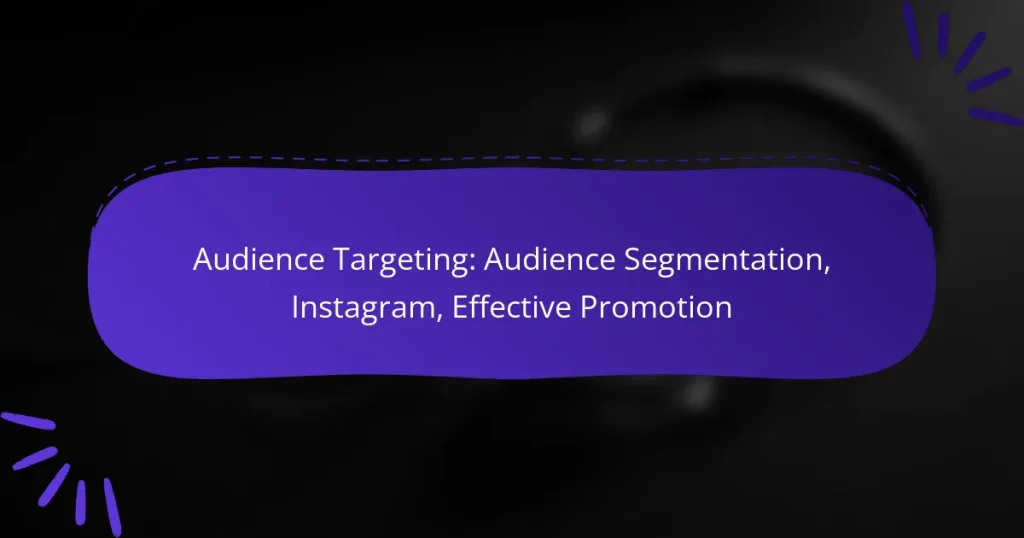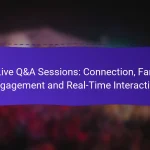Audience targeting on Instagram is crucial for effective promotion, as it allows brands to segment their market into distinct groups based on shared characteristics. By utilizing various tools to analyze user data and behavior, marketers can create tailored strategies that resonate with specific segments, enhancing engagement and conversion rates. Focusing on personalized messaging and content that aligns with audience preferences is key to driving successful campaigns.
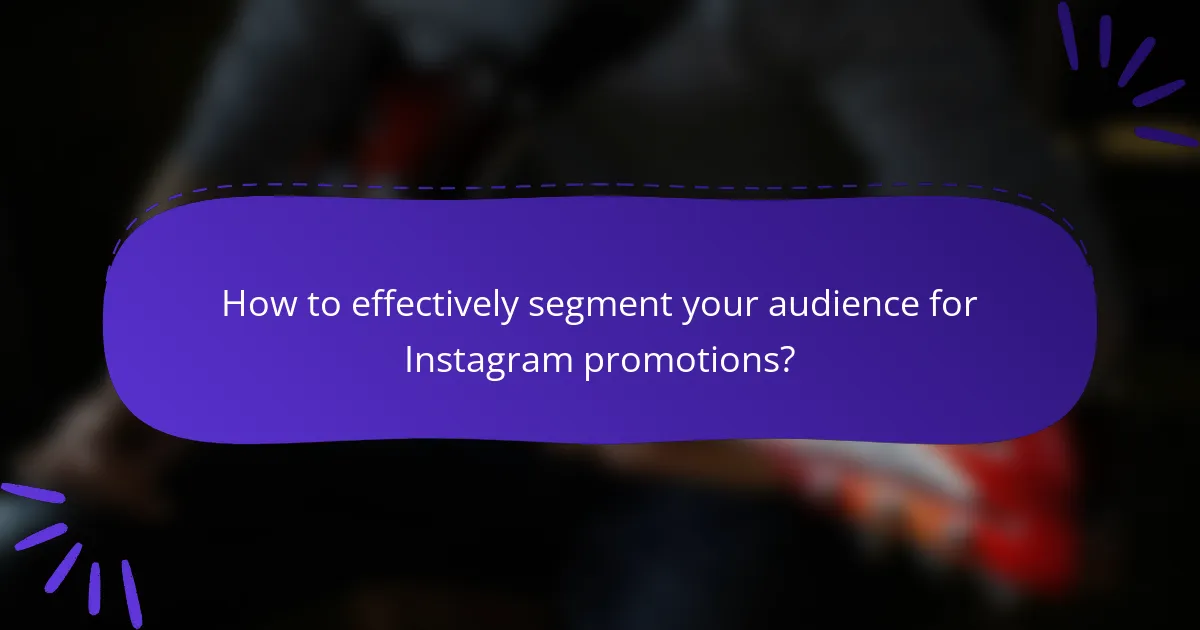
How to effectively segment your audience for Instagram promotions?
Effectively segmenting your audience for Instagram promotions involves dividing your target market into distinct groups based on shared characteristics. This approach allows for more tailored marketing strategies that resonate with specific segments, ultimately enhancing engagement and conversion rates.
Demographic segmentation
Demographic segmentation focuses on characteristics such as age, gender, income, education, and marital status. For instance, a brand targeting young adults may create content that appeals specifically to individuals aged 18-24, using language and visuals that resonate with that age group.
When implementing demographic segmentation, consider using Instagram Insights to analyze your current followers. This data can help you identify which demographics are most engaged with your content, allowing you to refine your promotional strategies accordingly.
Behavioral segmentation
Behavioral segmentation categorizes audiences based on their interactions with your brand, including purchase history, usage frequency, and brand loyalty. For example, you might target frequent buyers with exclusive offers, while new followers could receive welcome discounts to encourage their first purchase.
To effectively use behavioral segmentation, track user actions through Instagram analytics and adjust your promotions based on observed behaviors. This can lead to more personalized marketing efforts that cater to the specific needs and preferences of different user groups.
Psychographic segmentation
Psychographic segmentation delves into the interests, values, and lifestyles of your audience. This approach helps you understand what motivates your followers, allowing you to create content that aligns with their beliefs and aspirations. For example, a brand promoting eco-friendly products may target environmentally conscious consumers.
Utilize surveys or polls on Instagram Stories to gather insights about your audience’s preferences and values. This information can guide your content creation and promotional strategies, ensuring they resonate on a deeper emotional level.
Geographic segmentation
Geographic segmentation divides your audience based on their location, such as country, region, or city. This is particularly useful for businesses with location-specific offerings, like local restaurants or services. For instance, a café in Paris may promote seasonal menu items that appeal to local tastes.
Consider tailoring your promotions to reflect local events or cultural nuances. Using Instagram’s location tagging feature can also help you reach users in specific areas, enhancing the relevance of your campaigns.
Technographic segmentation
Technographic segmentation categorizes audiences based on their technology usage, including device type, operating system, and social media habits. Understanding whether your audience primarily uses smartphones or tablets can influence your content format and design.
To leverage technographic segmentation, analyze the devices your followers use to access Instagram. This data can inform your promotional strategies, ensuring your content is optimized for the platforms and devices most commonly used by your target audience.
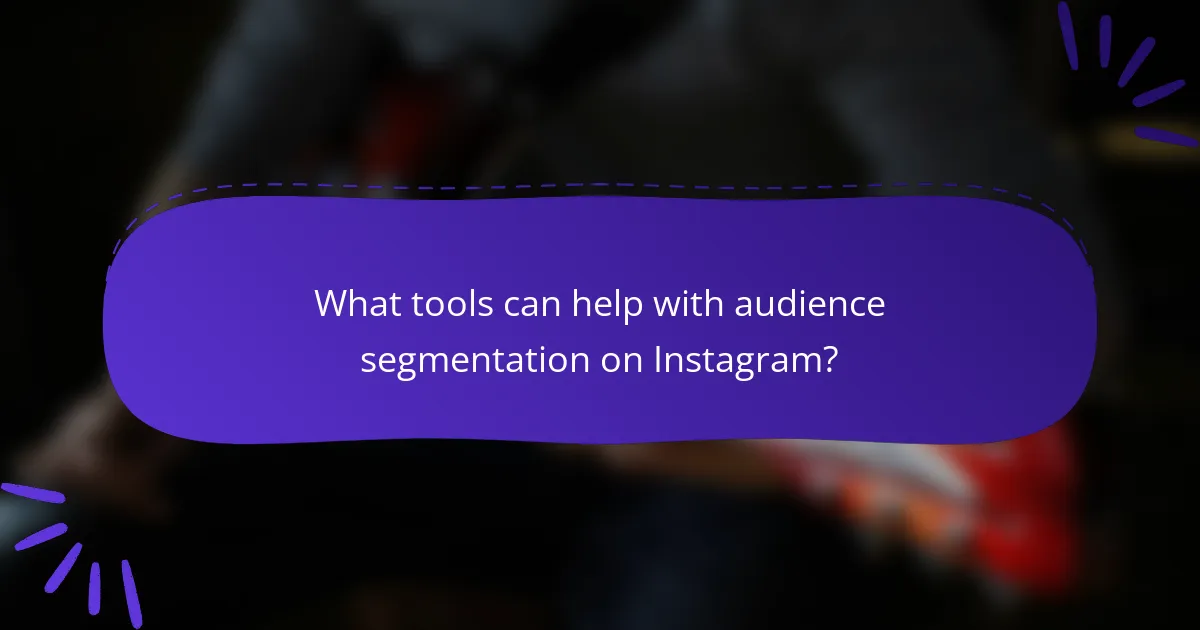
What tools can help with audience segmentation on Instagram?
Several tools can assist with audience segmentation on Instagram, allowing marketers to tailor their promotions effectively. These tools analyze user data and behavior, helping to identify distinct audience groups for targeted marketing strategies.
Facebook Audience Insights
Facebook Audience Insights is a powerful tool that provides detailed demographic information about your audience on Instagram. It allows you to explore data such as age, gender, location, and interests, which can help you create more targeted content and ads.
To use this tool, link your Instagram account to your Facebook page. You can then access insights on your followers and potential audiences, enabling you to refine your marketing strategies based on real data.
Hootsuite
Hootsuite offers comprehensive social media management features, including audience segmentation capabilities for Instagram. It allows you to monitor engagement metrics and analyze your audience’s behavior across different demographics.
Utilize Hootsuite’s analytics to identify which posts resonate most with specific audience segments. This can guide your content creation and promotional efforts, ensuring that you reach the right people with the right message.
Sprout Social
Sprout Social provides robust analytics tools that help you segment your Instagram audience effectively. It offers insights into follower demographics, engagement patterns, and content performance, allowing you to tailor your marketing approach.
By leveraging Sprout Social’s reporting features, you can create targeted campaigns that speak directly to the interests and behaviors of different audience segments, maximizing your promotional impact.
Canva
Canva, primarily known for its design capabilities, also offers features that can aid in audience segmentation on Instagram. You can create visually appealing content tailored to specific audience groups based on insights gathered from other tools.
Use Canva’s templates to design targeted posts and stories that align with the preferences of your segmented audiences. This visual approach can enhance engagement and improve the effectiveness of your promotional efforts on Instagram.
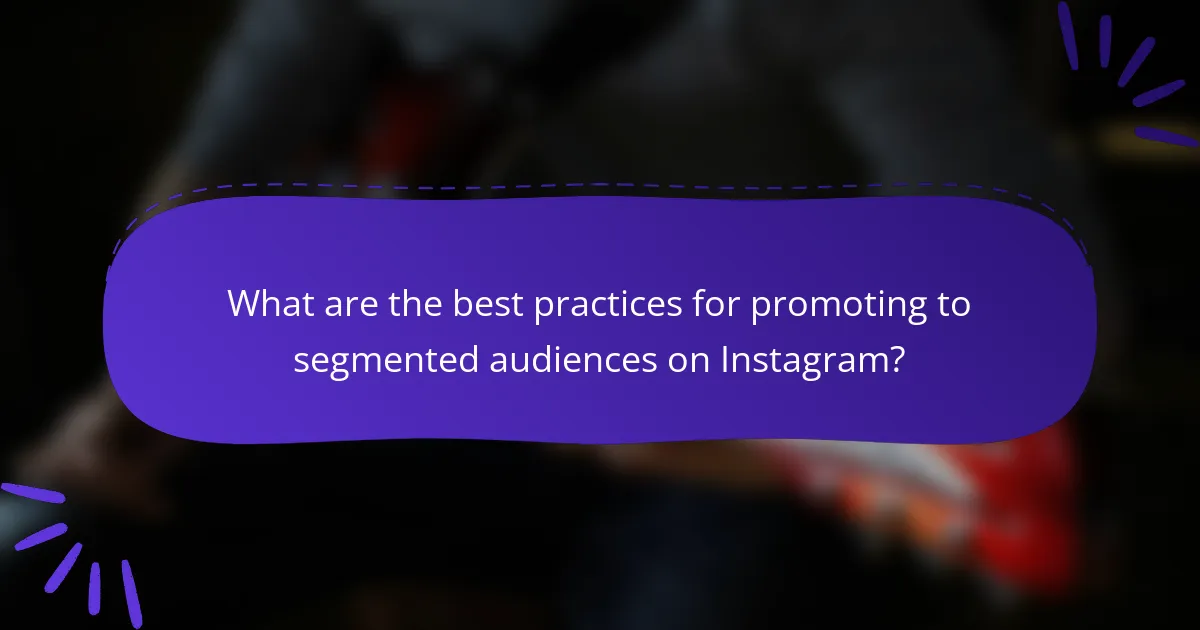
What are the best practices for promoting to segmented audiences on Instagram?
To effectively promote to segmented audiences on Instagram, brands should focus on tailored messaging and content that resonates with specific groups. This involves understanding audience preferences and behaviors to create relevant campaigns that drive engagement and conversions.
Personalized content creation
Creating personalized content is essential for engaging segmented audiences on Instagram. This means developing visuals and messaging that speak directly to the interests and needs of each audience segment. For example, a fashion brand might showcase different styles for various demographics, such as casual wear for younger audiences and professional attire for older professionals.
Utilizing user-generated content can also enhance personalization. Encourage customers to share their experiences with your products, and feature these posts on your profile to foster a sense of community and connection.
Targeted ad campaigns
Targeted ad campaigns allow brands to reach specific audience segments with tailored advertisements. Use Instagram’s robust targeting options, such as demographics, interests, and behaviors, to ensure your ads are seen by the right people. For instance, a fitness brand could target ads to users interested in health and wellness, focusing on specific age groups or locations.
Monitor ad performance and adjust your strategy based on engagement metrics. A/B testing different ad creatives can help identify what resonates best with each segment, optimizing your budget and maximizing impact.
Engagement through stories
Instagram Stories are a powerful tool for engaging segmented audiences due to their ephemeral nature and high visibility. Use Stories to share behind-the-scenes content, product launches, or exclusive promotions tailored to specific segments. For example, a beauty brand might create a Story series featuring makeup tutorials for different skin types.
Encourage interaction by using polls, questions, and quizzes in your Stories. This not only boosts engagement but also provides valuable insights into audience preferences, allowing for further segmentation and targeted content creation.
Utilizing Instagram influencers
Partnering with Instagram influencers can amplify your reach to segmented audiences effectively. Choose influencers whose followers align with your target demographics to ensure authenticity and relevance. For example, a travel brand might collaborate with influencers who specialize in adventure tourism, appealing to a younger, thrill-seeking audience.
When working with influencers, provide clear guidelines on messaging while allowing them creative freedom to maintain authenticity. Track the performance of influencer campaigns to measure their impact on engagement and conversions, adjusting your approach as needed for future collaborations.
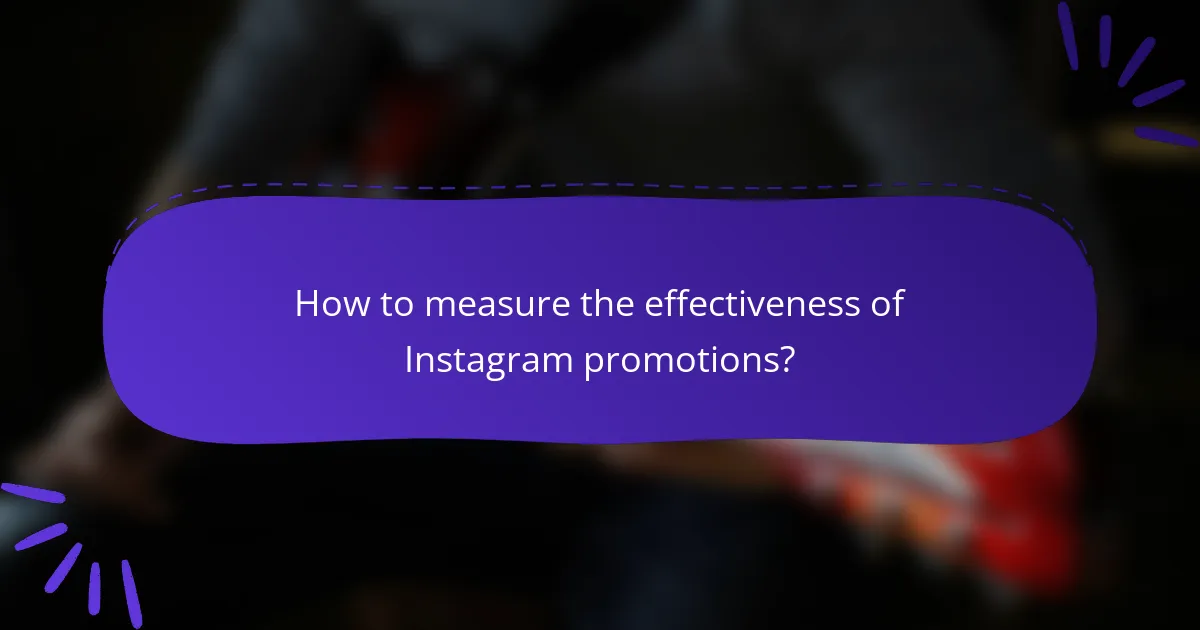
How to measure the effectiveness of Instagram promotions?
To measure the effectiveness of Instagram promotions, focus on key performance indicators (KPIs) such as engagement metrics, conversion rates, and insights from Instagram’s analytics tools. These metrics provide a clear picture of how well your promotional efforts resonate with your audience and drive desired actions.
Tracking engagement metrics
Engagement metrics include likes, comments, shares, and saves on your promotional posts. High engagement indicates that your content is resonating with your audience, while low engagement may suggest a need for content adjustment. Aim for engagement rates of 1-3% as a general benchmark for effectiveness.
To track these metrics, use Instagram’s native analytics or third-party tools. Regularly review these numbers to identify trends and adjust your strategy accordingly. For example, if video content receives significantly more engagement than static images, consider increasing your video promotions.
Analyzing conversion rates
Conversion rates measure the percentage of users who take a desired action after interacting with your promotion, such as visiting your website or making a purchase. A good conversion rate on Instagram typically ranges from 1-3%, but this can vary by industry. Monitor these rates to assess the effectiveness of your call-to-action.
To improve conversion rates, ensure that your promotional content is clear and compelling. Use strong calls-to-action and make it easy for users to follow through. For instance, if you’re promoting a product, include a direct link in your bio or use Instagram Shopping features to streamline the purchasing process.
Using Instagram Insights
Instagram Insights is a powerful tool that provides detailed analytics about your posts, stories, and audience. It allows you to track engagement, reach, impressions, and demographic information about your followers. Utilize this data to refine your promotional strategies and better target your audience.
To access Instagram Insights, switch to a business account if you haven’t already. Regularly check these insights to understand which types of content perform best and at what times your audience is most active. This information can guide your future promotions and help maximize their effectiveness.
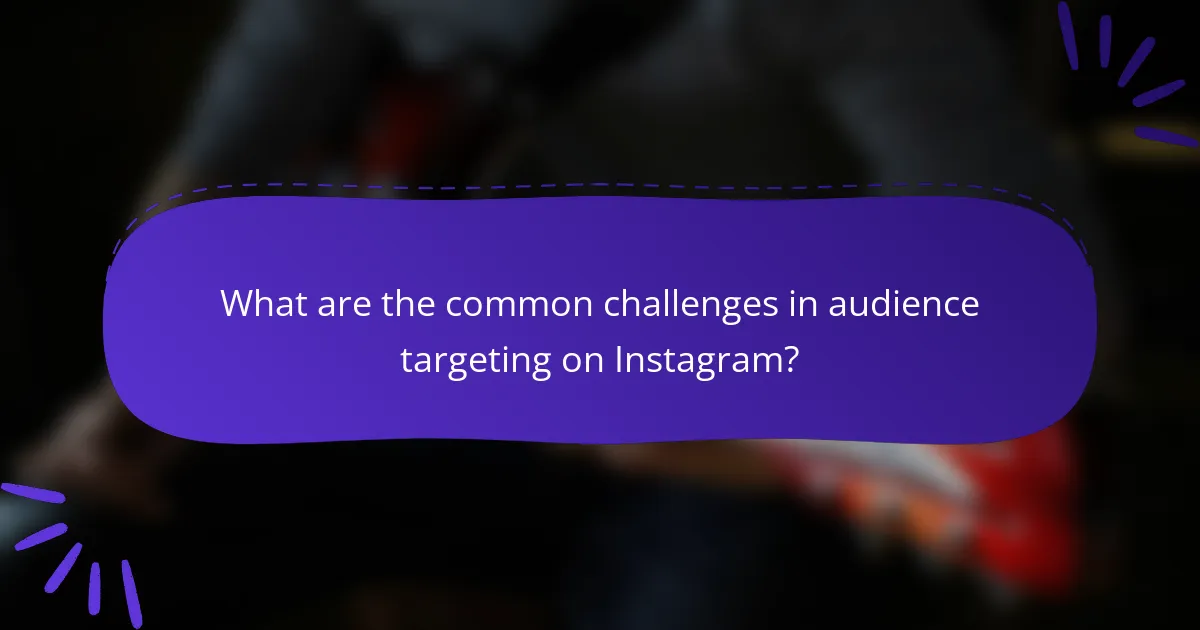
What are the common challenges in audience targeting on Instagram?
Audience targeting on Instagram faces several challenges that can hinder effective promotion. Key issues include data privacy concerns, changing algorithms, and content saturation, all of which require marketers to adapt their strategies continually.
Data privacy concerns
Data privacy has become a significant challenge for audience targeting on Instagram, especially with regulations like GDPR in Europe and CCPA in California. These laws restrict how user data can be collected and used, making it harder for marketers to gather insights about their audience.
To navigate these concerns, businesses should prioritize transparency and obtain explicit consent from users before collecting data. Utilizing aggregated data and focusing on first-party data can help mitigate risks while still enabling effective targeting.
Changing algorithms
Instagram’s algorithms are constantly evolving, affecting how content is displayed to users. These changes can impact the visibility of promotional posts, making it essential for marketers to stay updated on algorithm trends to maintain engagement.
To adapt, brands should diversify their content strategies, incorporating various formats like stories, reels, and IGTV. Regularly analyzing engagement metrics can help identify what resonates with the audience under the current algorithmic conditions.
Content saturation
With millions of posts shared daily, content saturation poses a challenge for audience targeting on Instagram. Users are bombarded with information, making it difficult for brands to stand out and capture attention.
To combat saturation, marketers should focus on creating unique, high-quality content that offers value to their audience. Utilizing targeted ads and engaging with followers through comments and direct messages can also enhance visibility and foster community engagement.
